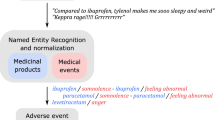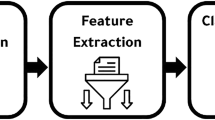Abstract
Adverse Drug Reactions (ADRs) pose a significant public health concern. In recent years, the use of social media data, particularly Twitter, has emerged as a valuable resource for identifying ADRs. The objective is to leverage machine learning and data mining algorithms to extract pertinent information from this platform, with the aim of identifying ADRs that could avert fatalities and hospitalizations. A novel ensemble ADR approach (EADR) is proposed in this study to detect ADRs from Twitter data. The EADR method encompasses several steps, including Twitter data preprocessing, addressing data imbalance through a combination of oversampling and under sampling methods, feature extraction, and the utilization of a Stacking Model, a classification system based on ensemble learning. Experimental results from the Twitter data set demonstrate that the proposed stacking method outperforms its single models in the first level, yielding an 87% F-score, 86% recall, and 87% precision, thus show casing its efficacy in ADR detection.











Similar content being viewed by others
References
Alam S, Yao N (2019) The impact of preprocessing steps on the accuracy of machine learning algorithms in sentiment analysis. Comput Math Organ Theory 25:319–335
Dai H-J, Wang C-K (2019) Classifying adverse drug reactions from imbalanced twitter data. Int J Med Inform 129:122–132
Deniz A, Angin M, Angin P (2021) Evolutionary multiobjective feature selection for sentiment analysis. IEEE Access 9:142982–142996
Dharma EM, Gaol FL, Warnars H, Soewito B (2022) The accuracy comparison among word2vec, glove, and fasttext towards convolution neural network (cnn) text classification. J Theor Appl Inf Technol 100:31
Famili A, Shen W-M, Weber R, Simoudis E (1997) Data preprocessing and intelligent data analysis. Intell Data Anal 1:3–23
Jiang H, Qiu Y, Hou W, Cheng X, Yim MY, Ching W-K (2018) Drug side-effect profiles prediction: from empirical to structural risk minimization. IEEE/ACM Trans Comput Biol Bioinf 17:402–410
Johnson JM, Khoshgoftaar TM (2019) Survey on deep learning with class imbalance. J Big Data 6:1–54
Keyvanpour M, Karimi Zandian Z, Heidarypanah M (2020) OMLML: a helpful opinion mining method based on lexicon and machine learning in social networks. Soc Netw Anal Min 10:1–17
Kim Y, Meystre SM (2020) Ensemble method–based extraction of medication and related information from clinical texts. J Am Med Inform Assoc 27:31–38
Korkontzelos I, Nikfarjam A, Shardlow M, Sarker A, Ananiadou S, Gonzalez GH (2016) Analysis of the effect of sentiment analysis on extracting adverse drug reactions from tweets and forum posts. J Biomed Inform 62:148–158
Le Glaz A, Haralambous Y, Kim-Dufor D-H, Lenca P, Billot R, Ryan TC, Marsh J, Devylder J, Walter M, Berrouiguet S (2021) Machine learning and natural language processing in mental health: systematic review. J Med Internet Res 23:e15708
Lee CY, Chen Y-PP (2019) Machine learning on adverse drug reactions for pharmacovigilance. Drug Discov Today 24:1332–1343
Leevy JL, Khoshgoftaar TM, Bauder RA, Seliya N (2018) A survey on addressing high-class imbalance in big data. J Big Data 5:1–30
Li Z, Lin H, Zheng W (2020a) An effective emotional expression and knowledge-enhanced method for detecting adverse drug reactions. IEEE Access 8:87083–87093
Li Z, Yang Z, Luo L, Xiang Y, Lin H (2020b) Exploiting adversarial transfer learning for adverse drug reaction detection from texts. J Biomed Inform 106:103431
Liakos KG, Busato P, Moshou D, Pearson S, Bochtis D (2018) Machine learning in agriculture: a review. Sensors 18:2674
Liu J, Zhao S, Zhang X (2016) An ensemble method for extracting adverse drug events from social media. Artif Intell Med 70:62–76
Liu J, Zhao S, Wang G (2018) SSEL-ADE: a semi-supervised ensemble learning framework for extracting adverse drug events from social media. Artif Intell Med 84:34–49
Masino AJ, Forsyth D, Fiks AG (2018) Detecting adverse drug reactions on Twitter with convolutional neural networks and word embedding features. J Healthc Inform Res 2:25–43
Mukherjee P, Badr Y, Doppalapudi S, Srinivasan SM, Sangwan RS, Sharma R (2021) Effect of negation in sentences on sentiment analysis and polarity detection. Procedia Comput Sci 185:370–379
Nalini S, Balasubramanie P (2019) Socia media opinions aware adverse drug effect prediction and prevention system for the secured health care medical environment. Clust Comput 22:12827–12837
Nikfarjam A, Sarker A, O’connor K, Ginn R, Gonzalez G (2015) Pharmacovigilance from social media: mining adverse drug reaction mentions using sequence labeling with word embedding cluster features. J Am Med Inform Assoc 22:671–681
Polvimoltham P, Sinapiromsaran K (2021) Mass ratio variance majority undersampling and minority oversampling technique for class imbalance. Front Artif Intell Appl 340:152–161
Rezaei Z, Ebrahimpour-Komleh H, Eslami B, Chavoshinejad R, Totonchi M (2020) Adverse drug reaction detection in social media by deep learning methods. Cell J 22:319
Sarker A, Gonzalez G (2015) Portable automatic text classification for adverse drug reaction detection via multi-corpus training. J Biomed Inform 53:196–207
Scaboro S, Portelli B, Chersoni E, Santus E, Serra G (2023) Extensive evaluation of transformer-based architectures for adverse drug events extraction. Knowl-Based Syst 275:110675
Shen C, Lin H, Guo K, Xu K, Yang Z, Wang J (2019) Detecting adverse drug reactions from social media based on multi-channel convolutional neural networks. Neural Comput Appl 31:4799–4808
Yan D, Li K, Gu S, Yang L (2020) Network-based bag-of-words model for text classification. IEEE Access 8:82641–82652
Zhang T, Lin H, Ren Y, Yang L, Xu B, Yang Z, Wang J, Zhang Y (2019) Adverse drug reaction detection via a multihop self-attention mechanism. BMC Bioinform 20:1–11
Alsharef A, Aggarwal K, Koundal D, Alyami H, Ameyed D (2022) An automated toxicity classification on social media using LSTM and word embedding. Comput Intell Neurosci
Anandarajan M, Hill C, Nolan T (2019), Practical text analytics. Maximizing the Value of Text Data.(Advances in Analytics and Data Science. Vol. 2.) Springer, 45-59.
Dongre S, Agrawal J (2023). Deep learning-based drug recommendation and ADR detection healthcare model on social media. IEEE Transact Comput Soc Syst.
Ferreira CHP, De Franca FO, Medeiros DR (20180. Combining multiple views from a distance based feature extraction for text classification, 2018 IEEE congress on evolutionary computation (CEC). IEEE, pp. 1–8.
Goularas D, Kamis S (2019). Evaluation of deep learning techniques in sentiment analysis from twitter data, 2019 International conference on deep learning and machine learning in emerging applications (Deep-ML). IEEE, pp. 12–17.
Huang J-Y, Lee W-P, Lee K-D (2022) Predicting adverse drug reactions from social media posts: data balance, feature selection and deep learning, Healthcare. MDPI, p. 618.
Huynh T, He Y, Willis A, Rüger S (2016). Adverse drug reaction classification with deep neural networks. Coling.
Islam T, Hussain N, Islam S, Chakrabarty A (2018) Detecting adverse drug reaction with data mining and predicting its severity with machine learning, 2018 IEEE region 10 humanitarian technology conference (R10-HTC). IEEE, pp. 1–5.
Lee K, Qadir A, Hasan SA, Datla V, Prakash A, Liu J, Farri O (2017). Adverse drug event detection in tweets with semi-supervised convolutional neural networks, Proceedings of the 26th international conference on world wide web, pp. 705–714.
Ma F, Meng C, Xiao H, Li Q, Gao J, Su L, Zhang A (2017). Unsupervised discovery of drug side-effects from heterogeneous data sources, Proceedings of the 23rd ACM SIGKDD international conference on knowledge discovery and data mining, pp. 967–976.
Naz H, Ahuja S, Nijhawan R, Ahuja NJ (2023), Impact of data pre‐processing in information retrieval for data analytics. Machine intelligence, big data analytics, and IoT in image processing: practical applications, 197–224.
Odeh F, Taweel A (2019), A deep learning approach to extracting adverse drug reactions, 2019 IEEE/ACS 16th international conference on computer systems and applications (AICCSA). IEEE, pp. 1–6.
Olson DL, Delen D (2008). Advanced data mining techniques. Springer Science & Business Media.
Pourebrahim B, Keyvanpour M (2020). Adverse drug reaction detection using data mining techniques: a review article, 2020 10th international conference on computer and knowledge engineering (ICCKE). IEEE, pp. 118–123.
Rakhsha M, Keyvanpour MR, Shojaedini SV (2021). Detecting adverse drug reactions from social media based on multichannel convolutional neural networks modified by support vector machine, 2021 7th international conference on web research (ICWR). IEEE, pp. 48–52.
Resyanto F, Sibaroni Y, Romadhony A (2019). Choosing the most optimum text preprocessing method for sentiment analysis: Case: iPhone Tweets, 2019 Fourth international conference on informatics and computing (ICIC). IEEE, pp. 1–5.
Sadeghi SS, Keyvanpour M (2019), RCDR: a recommender based method for computational drug repurposing, 2019 5th conference on knowledge based engineering and innovation (KBEI). IEEE, pp. 467–471.
Savargiv M, Masoumi B, Keyvanpour MR (2020). A new ensemble learning method based on learning automata. J Ambient Intell Humaniz Comput, 1–16.
Shahri MP, Tahmasebi A, Ye B, Zhu H, Aslam J, Ferris T, (2020). An ensemble approach for automatic structuring of radiology reports. arXiv preprint arXiv:2010.02256.
Tiwari D, Kumar M (2020). Social media data mining techniques: a survey, Information and communication technology for sustainable development: proceedings of ICT4SD 2018. Springer, pp. 183–194.
Wu C, Wu F, Yuan Z, Liu J, Huang Y, Xie X (2019). MSA: jointly detecting drug name and adverse drug reaction mentioning tweets with multi-head self-attention, Proceedings of the Twelfth ACM international conference on web search and data mining, pp. 33–41.
Yu L, Zhou N, (2021) Survey of imbalanced data methodologies. arXiv preprint arXiv:2104.02240.
Zhou Z-H (2021) Machine learning. Springer Nature.
Funding
This research did not receive any specific grant funding agencies in the public, commercial, or not-for- profit sectors.
Author information
Authors and Affiliations
Contributions
Dr. M. R. Keyvanpour is the head of the research team in the data mining laboratory, and the ideation and final supervision was done by him. S. Mehrmolaei was responsible for writing the text of the article and editing the English of the article. B. Pourebrahim was responsible for data collection and technique implementation of the article.
Corresponding author
Ethics declarations
Conflict of interest
The authors report no declaration of interest.
Additional information
Publisher's Note
Springer Nature remains neutral with regard to jurisdictional claims in published maps and institutional affiliations.
Rights and permissions
Springer Nature or its licensor (e.g. a society or other partner) holds exclusive rights to this article under a publishing agreement with the author(s) or other rightsholder(s); author self-archiving of the accepted manuscript version of this article is solely governed by the terms of such publishing agreement and applicable law.
About this article
Cite this article
Keyvanpour, M.R., Pourebrahim, B. & Mehrmolaei, S. EADR: an ensemble learning method for detecting adverse drug reactions from twitter. Soc. Netw. Anal. Min. 14, 83 (2024). https://doi.org/10.1007/s13278-024-01239-4
Received:
Revised:
Accepted:
Published:
DOI: https://doi.org/10.1007/s13278-024-01239-4




